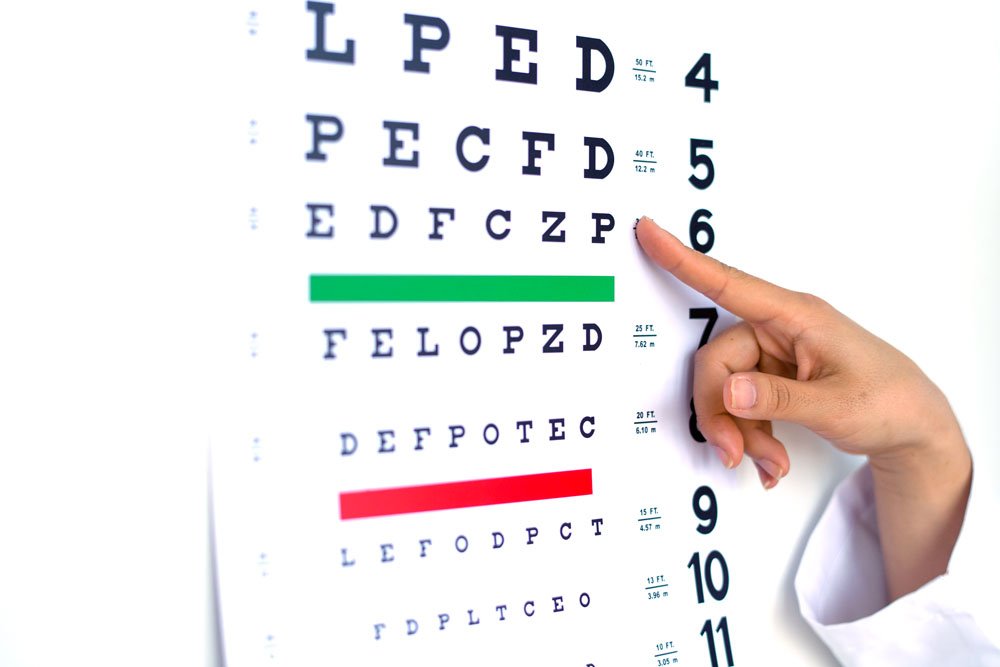Eye test
Eye test – visual acuity examinations
Central visual acuity is medically referred to as visual acuity. Visual acuity is the ability of the eye to perceive two points close to each other separately. The place where visual acuity is determined is the center of the retina, where in the point of sharpest vision (fovea centralis) the cones are responsible for the dividing shafts.
Full visual acuity is achieved at a visual acuity of 1.0 or 100 percent. Many adolescents achieve a higher value and thus better visual acuity. With increasing age, visual acuity decreases continuously. For most activities of daily living, a visual acuity of 0.5 to 0.6 is sufficient.
Modern fully automated devices that examine visual acuity work on the principle of the refractometer. A stick figure is projected through the pupil onto the retina, similar to a slide being thrown onto a wall. Next, lenses are switched in the device in front of the projection until the image of the stick figure on the retina is sharp.

Vision test for pilots
Generally, I do the eye test as part of the aeromedical examination.
However, everyone has to see an ophthalmologist in the following cases:
- When the strength of the glasses has changed
- for presbyopia
- in case of condition after surgical intervention on the eye
- For eye diseases
The examination findings are entered in a special form: ophthalmological examination report(forms download).
The ophthalmologic examination report must include the following examinations:
- Examination of the external eye and its accessory organs, refractive media (slit lamp), funduscopy, accommodation, convergence, ocular motility.
- Eye muscle balance
- Visual field
- Determination of the best-corrected and uncorrected near-far and intermediate visual acuity
- Determination of refraction
- Tonometry (eye pressure measurement) for applicants over 40 years of age
- Color vision test (Ishihara)
Which kinds of sight tests are there ?
- Vision test for visual acuity
- Refraction determination
- Color vision test
- Stereo eye test
- Color vision test important for pilots
Visual acuity is the ability of the eye to see two points separately. These two points form a visual angle – the angle at the sharpest point, the reciprocal of which is the visual acuity. If the angle of vision is 1 degree, for example, then the visual acuity is 1.0 – which corresponds to 100 percent. If there is an angle of 10 degrees, the visual acuity is 0.1 – this corresponds to 10 percent. If people can see normally, they have a visual acuity of 100 percent. This test is primarily performed when nearsightedness or farsightedness is suspected and is used in the aptitude test for the driver’s license.
A refraction is the refractive power of the eye, which can be determined by specifying the distance point. This distance point determination is called refraction determination, but is also known as spectacle lens or eyeglass determination. To determine this value, there are two methods of measurement – objective and subjective refraction determination. Often, these are also combined during examinations. While the objective determination takes place without questioning the patient and is automated by a refractometer, the subjective determination takes place under questioning of the examined and is determined with measuring glasses.
A color vision test checks how well the tester recognizes colors and can distinguish between them. Genetic defects in the eyes or diseases can cause colors to be difficult to see. There is the well-known red-green weakness or the rarer yellow-blue weakness. The examination uses various color plates on which images are built up from small color dots. Patients with color vision deficiencies are usually not able to distinguish them well and cannot recognize the different color contrasts. This can have occupational implications,
Stereo vision means the ability of spatial vision. There are many different methods and examination options for this test. The Lang stereotest I and II are often used, in which the patient is presented with a test card on which small black dots show three-dimensional images. These can only be recognized if stereo vision is intact.
In practice, this test is also suitable as a rapid screening method if, for example, there is a need for is to distinguish pseudostrabismus (e.g., epicanthus) from true strabismus. In the positive case, it suggests an intact stereopsis.
The color recognition is checked accordingly to EASA with the color charts (according to Ishihar) or on the anomaloscope (according to Nagel) or with a signal lantern.
Ishihara color charts are a simple eye test with different color charts, on which colored numbers and shapes can be recognized ,- the test is installed in all common eye test devices in Europe/Germany, it is very well known and widespread. It is actually very easy to pass.
Only if color vision disorders are really present, then it is necessary, actually also another chance, – by means of further tests still another possibility to receive sufficient color vision to be able to fly attested. In case that color vision disorders are really present it bis necessary to make further tests. Passing these tests the patient has „a second chance“ to testify the sufficient color vision that is necessary to be able to fly.
Generally important to know:
The examination with the color plates must take place under good lighting conditions. Results on the anomaloscope depend on the experience of the individual examiner.
There are 3 types of lanterns allowed. Spectrolux – Holmes Wright – Beynes. These lantern types are actually very difficult to buy as medical devices at the moment…. Also the AMC`s have problems with it.
It should be noted that the individual lantern types and test conditions can lead to different results. But there is no rule which test has to be passed.
The JAA conducted an investigation at the University of London in which applicants – who had failed the Ishihara test – were tested on the 3 lanterns and the anomaloscope.
Because the 3 lanterns have different light characteristics and luminous intensity and are tested according to different protocols, and at the same time the anomaloscope according to Nagel contains a completely different test principle, the comparative test has led, as expected, to different results for the same applicants.
At the AMC in London, testing is carried out with the Holmes Wright and Beynes type. You have to pass on type of lantern test. It is first tested according to Beynes.
No need to panic if you fail this test:
In Holland, the Holmes-Wright type is available. In Zurich the Spectrolux type is used, in Cologne the Beynes type.
You only have to pass a Latern test once. No new test is required for repeat ophthalmic examinations.
Holmes-Wright lantern consists of 2 superimposed lights, which can be red, green or white. All combinations are entered, i.e. a different color at the top and bottom or the same color at the top and bottom. Beynes lantern emits 5 different lights – red – green – blue – orange – white.
The following rules apply:
- no error in the first round -> test passed
- any red – green confusion -> automatically failed
- another error -> 2 more rounds are completed
- no error in both extra rounds -> test passed
- Error in round 2 or 3 -> Dark adaptation
- no error in the dark round -> test passed
- any error in the dark round -> automatically failed.
Fields of application and reasons
Reasons to have the eyes checked are the aptitude test for the driver’s license and the occupational health regulation, which states that employees in some professions are examined by the company doctor to ensure that they are able to perform their job correctly.
Occupational health eye test
The occupational health care is regulated in the occupational health regulation, which specifies quite precisely which employees require which preventive care. The regulationresults from the risk assessment, which lists which risks and potential health hazards are present at the workplace. This results in what kind of provision is offered and is consequently mandatory. The employer invites to this occupational health screening.
A limited ability to see can affect and reduce the performance of the employee. It can even endanger him and others. In work areas with intensive screen work, guard duties, driving and control activities (bus driver, pilot, train driver) as well as in operating activities in power plants or work as an electrician, etc., good visual performance is required. An eye test at the company doctor’s office, which checks visual acuity, color recognition, spatial vision and retinal function, can detect disorders at an early stage.
Eye test driving license
In order to get a driver’s license, you also need an eye test. This is used to check whether you can Suffice the demands of road traffic. The eye test must take place at an officially recognized eye test center. You need a certain level of vision to pass the driver’s license vision test. This is 0.7 – roughly 70 percent.
Even if the eye test has been passed, it does not mean that glasses are not needed. If you yourself notice that you are just barely meeting the requirements, or if you have had trouble and even difficulty seeing everything well, then you should have another eye test done on your own and if possible try to use vision aids to help your eye quality.
Make your appointment online today….





